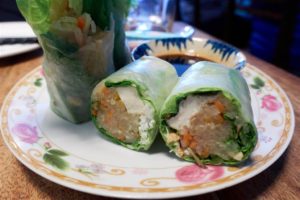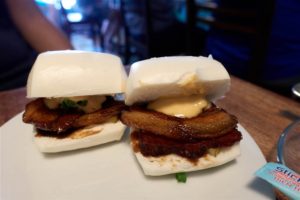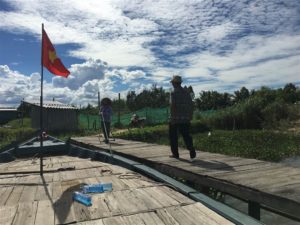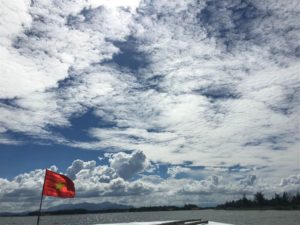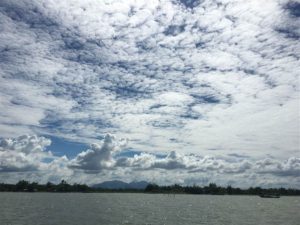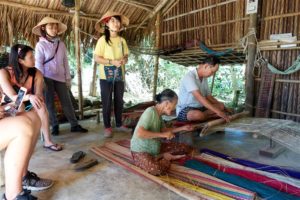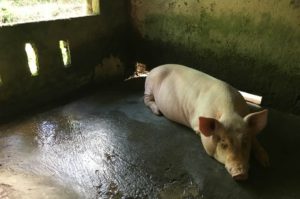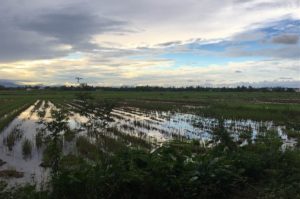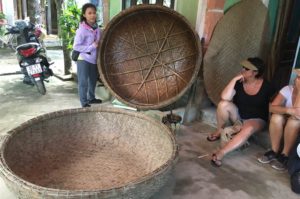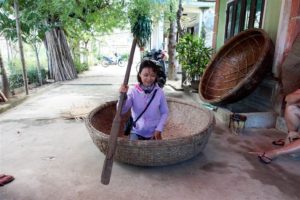Beyond Pho – Biking Between Heaven and Earth
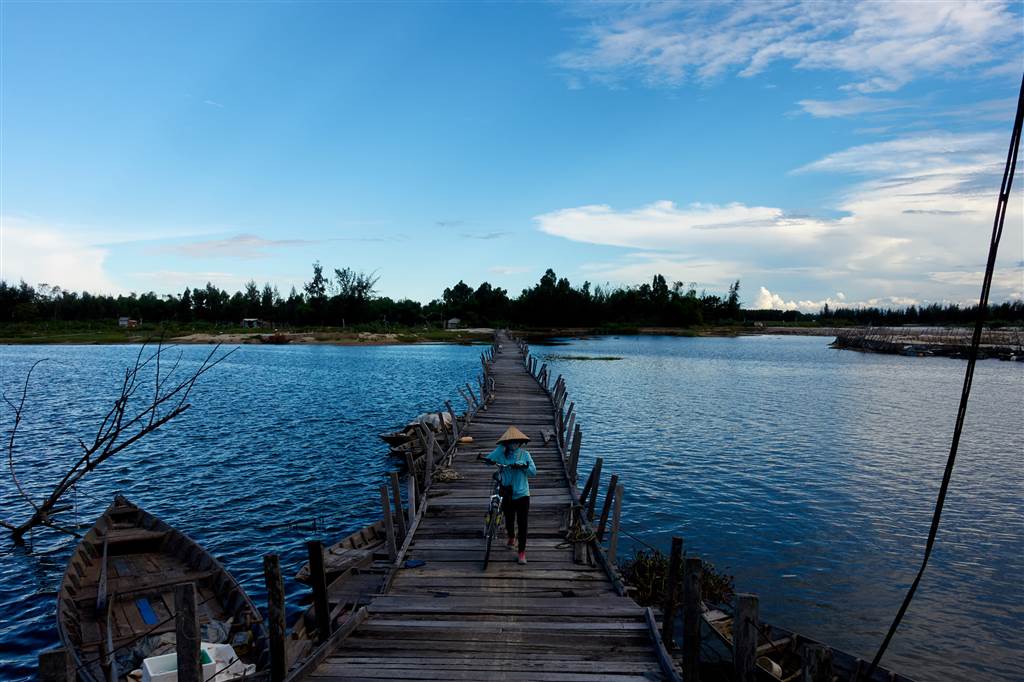
We joined a biking tour on this sunny day.
The Nu Eatery
Lunch was at the Nu Eatery. The restaurant was known for its fusion touch on traditional Vietnamese cuisine. We had to try our luck as we did not make a reservation, and luck we had. At late morning we arrived at Nu, which was tucked away in a residential neighborhood. There was a table. We sat down with their famous pork bun, a watercress salad, and a rice paper roll. As with every meal, we finished with a cup of ca-phe sua da (iced coffee with milk). In terms of volume, there was not a lot of food. And yet each dish was so tasty that we were fully satisfied.
Heaven and Earth Biking Tour
We joined Heaven and Earth Biking Tour for this afternoon. The traditional countryside bicycle tour took us on a 45-minute boat ride to an island across the Song Thu River Delta. As we loaded our bicycles on the boat, I was incredibly excited to be able to see the village life of Vietnam up close.
On the boat ride an older man was at the helm. We tried to have a friendly conversation, although we did not speak a common language. He said, “Vietnam, Vietnam” to me. I knew then he was giving a word of praise. Over the years, especially having traveled in Southeast Asia, I came to understand that the locals were paying a compliment when they thought of you as their own. He showed me a picture of him in a crisp military uniform. He had served in the military before.
At our first stop in the villages of this unnamed island (I never found out what island it was), we came to see the art of weaving. A couple was weaving a beautiful tapestry. Our two very colorful young guides asked us questions. “If you get any of our questions right, you will get the ticket to the boat ride back to Hoi An!”
Tapestry-Weaving
The couple was weaving a beautiful sleeping mat. I thought the material could have been rattan. It is a common material in Asia that adds a nice, cool touch to the surface. It is perfect for sleeping mats in the hot and humid nights of Vietnam. “How long does it take for this man to weave a mat?” I had no clue how long it would take on this traditional hand-operated loom. Someone guessed right, “three to four hours!” Indeed, it takes one afternoon to make the product from start to finish.
Vietnamese Homes and Their Three Doorways
The four seasons of Vietnam are hot, hotter; wet, and wetter. At the traditional Vietnamese home the tour guides first showed us the high beams that give the roof its support. During the rainy season, Hoi An would come under the danger of serious flooding. When it floods, the villagers would have to take those beams as their last resort. The first thing to stuff at that level is the television, which for most families would be the most valuable piece of household appliance. Then they put all other furniture, sofa, chairs, tables, up there to the best they can. Yes, the flood can level as high as the ceiling of the houses.
A typical traditional home of Vietnam has three doorways. The men take the left, and the women take the right. “So who has the middle doorway?” Our lovely tour guides said to us. “The ancestors!” Everybody turned to look at me when I shouted the answer. I knew because this traditional home had an ancestral altar in the middle of the living room. And the middle doorway would be the direct through way to the altar. “You got your ticket back in Hoi An!” The tour guide Quic said cheerfully.
Scenery of Tranquility
We saw wonderful scenery in this large island as we biked. It was an intimate view of rural Vietnam. Fresh waterways crisscrossed everywhere within that island. As the sun began setting, we biked through a floating bridge. It scared me at first. But as we biked on, I realized that the bridge was very sturdy despite its looks.
Green shoots of grain waved gently at us in the wind. The growth of the rice paddies signaled a good second harvest for the year. The view of lush rice paddies comforted me. A good harvest might just be the only humble wish for farmers. They are tied to the land.
The interactions with the villagers revealed a life in tranquility. They did what their families did for generations. While the means of production may seem primitive to us, it was, in many instances, in harmony with nature. They fully appreciated the resourcefulness of the environment, and practiced sustainable farming.
For example, at the winemaker family home, the villagers reared pigs alongside their wine business. They had a way of collecting the methane from the manure, to power the lights in their home.
Basket Boats
The water is also a lifeline to the villages on this island. We visited the family that produced basket boats. The people of this island frequently ventured out on its waterways on the basket boats, which comfortably sit one or two persons. The boats are giant baskets. It was like the rattan baskets that villagers used for drying preserved veggies and seafood, except that it could sit a whole person. After hand-weaving the boats, the villagers applied a thick layer of cow manure. They then let the coating dry. The coating would keep the baskets water-proof.
The really interesting demonstration was how the villagers motioned the oars in order to move the boat forward. There were two ways to move the oars. Either drawing in the water the shape of infinity in front of the boat, or in the shape of the number “eight” as written in Chinese. That means doing short strokes on the two sides interchangeably. When some volunteers went on the basket boats, we could tell that either way was easier said than done. The tourists simply could not move the boat at all.
The price of these basket boats was 100 USD. Clearly, they were valuable as a means of livelihood.
Finally, the tour guides explained to us why the villagers painted fierce-looking eyes on the front of the standard village boats. They said that the most convincing theory was these eyes stared down at the river monsters. Thus the villagers were protected from the havoc raised by these monsters.
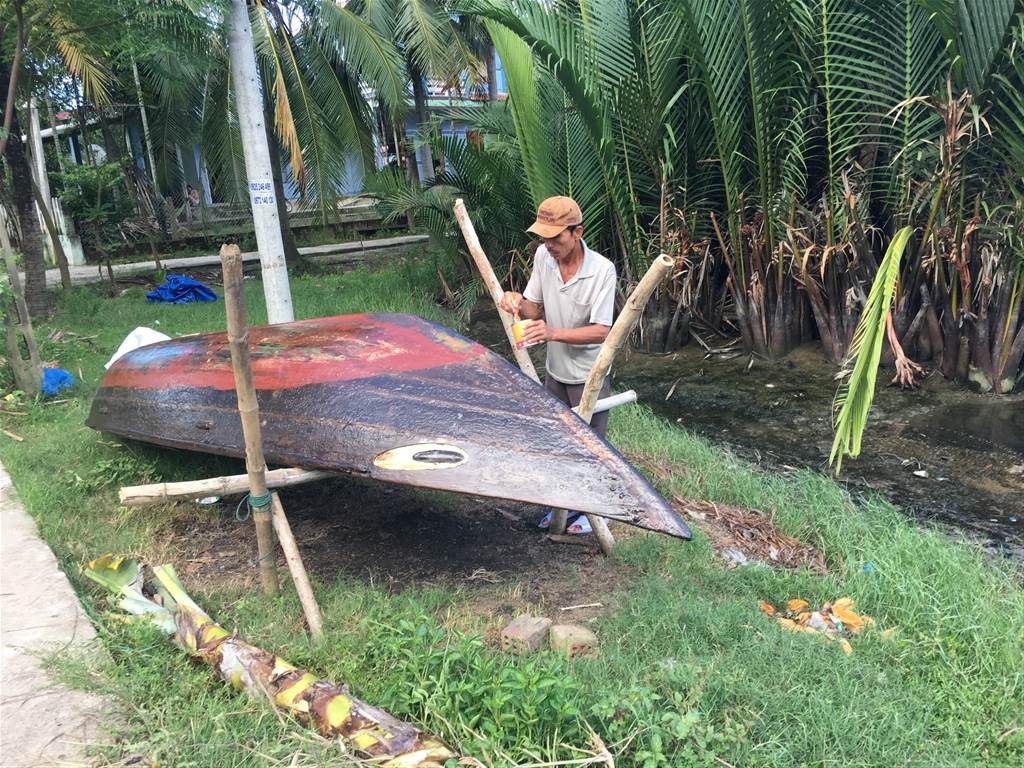
We began our tour after lunch, and the tour ended around 5pm or so. We shopped for some souvenirs and boarded the boat to ride back to Hoi An. The man at the helm changed his clothes, with a shiny white shirt and a suit jacket. He was looking more like the smart military officer on the picture he showed me.
We tipped generously for our two lovely tour guides on this bike tour. They were clever, sweet, and passionate about their job. I highly, highly recommend this bike tour for anyone visiting Hoi An.

